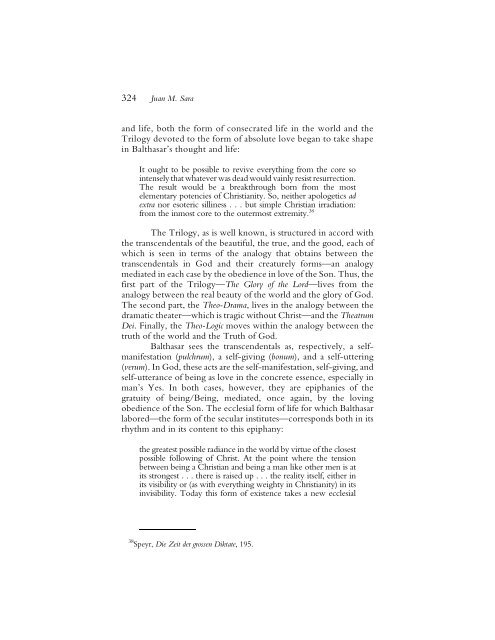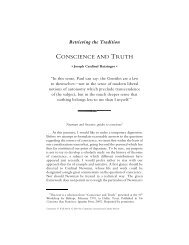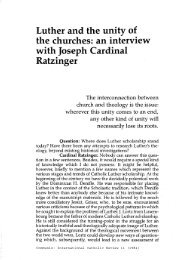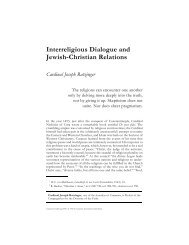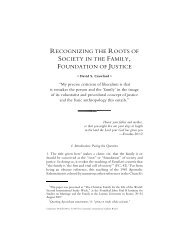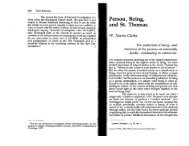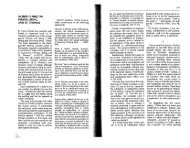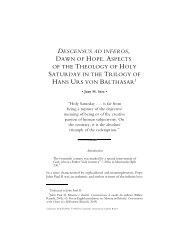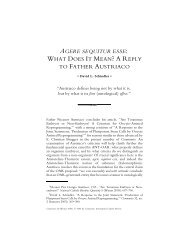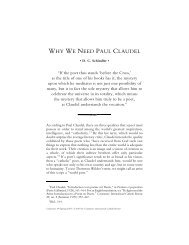Juan Sara. Secular Institutes According to Hans Urs ... - Communio
Juan Sara. Secular Institutes According to Hans Urs ... - Communio
Juan Sara. Secular Institutes According to Hans Urs ... - Communio
Create successful ePaper yourself
Turn your PDF publications into a flip-book with our unique Google optimized e-Paper software.
324 <strong>Juan</strong> M. <strong>Sara</strong><br />
and life, both the form of consecrated life in the world and the<br />
Trilogy devoted <strong>to</strong> the form of absolute love began <strong>to</strong> take shape<br />
in Balthasar’s thought and life:<br />
It ought <strong>to</strong> be possible <strong>to</strong> revive everything from the core so<br />
intensely that whatever was dead would vainly resist resurrection.<br />
The result would be a breakthrough born from the most<br />
elementary potencies of Christianity. So, neither apologetics ad<br />
extra nor esoteric silliness . . . but simple Christian irradiation:<br />
from the inmost core <strong>to</strong> the outermost extremity. 38<br />
The Trilogy, as is well known, is structured in accord with<br />
the transcendentals of the beautiful, the true, and the good, each of<br />
which is seen in terms of the analogy that obtains between the<br />
transcendentals in God and their creaturely forms—an analogy<br />
mediated in each case by the obedience in love of the Son. Thus, the<br />
first part of the Trilogy—The Glory of the Lord—lives from the<br />
analogy between the real beauty of the world and the glory of God.<br />
The second part, the Theo-Drama, lives in the analogy between the<br />
dramatic theater—which is tragic without Christ—and the Theatrum<br />
Dei. Finally, the Theo-Logic moves within the analogy between the<br />
truth of the world and the Truth of God.<br />
Balthasar sees the transcendentals as, respectively, a selfmanifestation<br />
(pulchrum), a self-giving (bonum), and a self-uttering<br />
(verum). In God, these acts are the self-manifestation, self-giving, and<br />
self-utterance of being as love in the concrete essence, especially in<br />
man’s Yes. In both cases, however, they are epiphanies of the<br />
gratuity of being/Being, mediated, once again, by the loving<br />
obedience of the Son. The ecclesial form of life for which Balthasar<br />
labored—the form of the secular institutes—corresponds both in its<br />
rhythm and in its content <strong>to</strong> this epiphany:<br />
the greatest possible radiance in the world by virtue of the closest<br />
possible following of Christ. At the point where the tension<br />
between being a Christian and being a man like other men is at<br />
its strongest . . . there is raised up . . . the reality itself, either in<br />
its visibility or (as with everything weighty in Christianity) in its<br />
invisibility. Today this form of existence takes a new ecclesial<br />
38 Speyr, Die Zeit der grossen Diktate, 195.


